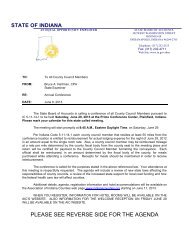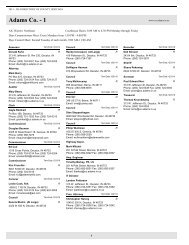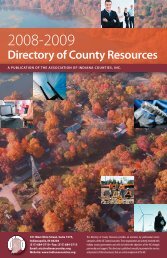Job Descriptions Play a Role in Employment Practice Risk Management
Job Descriptions Play a Role in Employment Practice Risk ...
Job Descriptions Play a Role in Employment Practice Risk ...
You also want an ePaper? Increase the reach of your titles
YUMPU automatically turns print PDFs into web optimized ePapers that Google loves.
<strong>Job</strong> <strong>Descriptions</strong><br />
<strong>Play</strong> a <strong>Role</strong><br />
<strong>in</strong> <strong>Employment</strong><br />
<strong>Practice</strong> <strong>Risk</strong><br />
<strong>Management</strong><br />
In a recent survey, only 44 percent of employers answered "Yes" to the question, “Do<br />
you have job descriptions.” Fifty percent said "No" and five percent said "Don't Know."<br />
This is reason for concern s<strong>in</strong>ce good job descriptions are critical to any organization.<br />
First, job descriptions help ensure that hir<strong>in</strong>g, promotion and lay-off practices are not<br />
discrim<strong>in</strong>atory. <strong>Job</strong> descriptions help employers defend decisions when employees claim<br />
they are wrongfully term<strong>in</strong>ated. <strong>Job</strong> descriptions also promote efficiency and fairness<br />
with<strong>in</strong> organizations by allow<strong>in</strong>g managers to make consistent decisions about tra<strong>in</strong><strong>in</strong>g,<br />
promotions, transfers, etc. F<strong>in</strong>ally, job descriptions are important for determ<strong>in</strong><strong>in</strong>g whether<br />
an employee can meet the essential functions of his or her job with or without reasonable<br />
accommodation.<br />
What Do <strong>Job</strong> <strong>Descriptions</strong> Do?<br />
• Set clear job expectations.<br />
• Give managers guidel<strong>in</strong>es to hire, promote and supervise employees.<br />
• Help support hir<strong>in</strong>g, discipl<strong>in</strong>ary, promotion, compensation and term<strong>in</strong>ation<br />
decisions.<br />
• Help an employer comply with numerous legal requirements.<br />
What Is The Legal Importance of <strong>Job</strong> <strong>Descriptions</strong> and Essential Functions?<br />
Here are a few of the statutes which can be impacted by your entity’s job descriptions.<br />
Fair Labor Standards Act (FLSA). The FLSA requires overtime pay for hours worked<br />
over 40 <strong>in</strong> a week by non-exempt employees. The exempt or non-exempt status of an<br />
employee is determ<strong>in</strong>ed, <strong>in</strong> part, on an employee’s duties. A written job description or<br />
title is not enough alone to satisfy the exempt requirements, but an accurate list of<br />
essential functions can go a long way <strong>in</strong> confirm<strong>in</strong>g an employee’s exempt status.<br />
Americans with Disabilities Act (ADA). It is a violation of the ADA to fail to provide<br />
reasonable accommodation to the known physical or mental limitations of a qualified<br />
<strong>in</strong>dividual with a disability, unless to do so would impose an undue hardship on the<br />
1
employer. The duty to accommodate relates to the employee’s essential job duties. In<br />
other words, the disabled employee must be able to perform the essential functions of the<br />
job, with or without accommodation. If a disabled employee is unable to perform an<br />
essential function of the job, even with an accommodation, the employer is not required<br />
to reta<strong>in</strong> the employee <strong>in</strong> that position. In this regard, it is important that an employee’s<br />
job description identify the position’s essential functions.<br />
Family and Medical Leave Act (FMLA). The FMLA requires that the employee’s health<br />
care provider certify that the medical condition for which the employee is seek<strong>in</strong>g leave<br />
renders the employee unable to perform one or more of the employee’s job functions.<br />
The FMLA further provides that, under specified conditions, an employer may require a<br />
return to work certificate from the employee’s health care provider before the employer is<br />
required to return the employee to work follow<strong>in</strong>g an FMLA leave. To assist the doctor<br />
<strong>in</strong> his/her assessment, the employer may attach a job description to the medical<br />
certification form. A complete and accurate list of essential functions will enable the<br />
health care provider to give an <strong>in</strong>formed op<strong>in</strong>ion.<br />
Federal and State Discrim<strong>in</strong>ation Laws. There are many state and federal statutes that<br />
prohibit discrim<strong>in</strong>ation based upon a protected status. When faced with a claim of<br />
discrim<strong>in</strong>ation from an employee, a well-written description can help support the<br />
challenged decision, whether it be related to compensation, promotion, discipl<strong>in</strong>e or<br />
discharge.<br />
What Composes a Standard <strong>Job</strong> Description?<br />
Typically a job description is composed of four sections:<br />
• A job summary – an overview of the position with a brief description of the most<br />
important functions.<br />
• A list of job requirements – education, certifications and experience necessary to<br />
do the job.<br />
• A list of job functions – a detailed description of the job duties. This section<br />
provides the basis for most of the employment decisions that are made concern<strong>in</strong>g<br />
the employees <strong>in</strong> this position.<br />
• Other <strong>in</strong>formation – any other important facts about this position <strong>in</strong>clud<strong>in</strong>g<br />
work<strong>in</strong>g hours, travel requirements, report<strong>in</strong>g relationships, location, physical<br />
requirements and work<strong>in</strong>g conditions.<br />
Best <strong>Practice</strong>s<br />
Prepar<strong>in</strong>g accurate job descriptions is the first step. However, job duties often change<br />
over time and an out-dated job description may be of little benefit or could even be a<br />
detriment. To ensure that your job descriptions rema<strong>in</strong> current and accurate, consider<br />
tak<strong>in</strong>g the follow<strong>in</strong>g steps:<br />
• Include the effective date on every job description and ensure that the date is<br />
revised when changes are made.<br />
2
• Confirm that the job description is current before post<strong>in</strong>g any open position.<br />
• Confirm that the job description is up-to-date as part of the performance review<br />
process.<br />
• Review all job descriptions on a set schedule. If this approach is not practicable,<br />
consider spot audits.<br />
MATERIALS PROVIDED, NEED FOR REVIEW BY COUNSEL AND OTHERS,<br />
APPLICABILITY AND SUITABILITY OF RECOMMENDATIONS.<br />
Attached are risk management related recommendations we believe may be of <strong>in</strong>terest to you. Provision of<br />
these materials by our organization (set forth <strong>in</strong> section one above and referred to as “us”, “our”, or<br />
“we”) does not constitute a representation of the appropriateness, adequacy or effectiveness of the<br />
recommendations.<br />
These materials are provided as recommendations only. They address certa<strong>in</strong> important <strong>Risk</strong> <strong>Management</strong><br />
matters. They are not suggested or <strong>in</strong>tended to provide for all circumstances or all considerations. Each<br />
situation is different <strong>in</strong> some respects, and the advice of counsel and, <strong>in</strong> many cases, other professionals, is<br />
required to prepare and implement an effective and lawful risk management related program, document or<br />
agreement. It is the responsibility of the local government to determ<strong>in</strong>e the suitability and applicability of<br />
these and other risk management materials to its particular needs and circumstances.<br />
3






